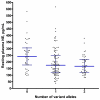Catecholamine pathway gene variation is associated with norepinephrine and epinephrine concentrations at rest and after exercise
- PMID: 22258110
- PMCID: PMC3303991
- DOI: 10.1097/FPC.0b013e328350a274
Catecholamine pathway gene variation is associated with norepinephrine and epinephrine concentrations at rest and after exercise
Abstract
Objective: To examine the hypothesis that genetic variation in enzymes and transporters associated with synthesis, storage, release, and metabolism of catecholamines contributes to the interindividual variability in plasma catecholamine concentrations at rest and after exercise.
Methods: We measured plasma norepinephrine (NE) and epinephrine concentrations at rest and after a standardized exercise protocol in 165 healthy individuals (60% White, 40% African-American) and examined 29 functional or common variants in 14 genes involved in synthesis, transport, or metabolism of catecholamines. We examined the relationship between genotypes and NE concentrations at rest and the increase after exercise (ΔNE) by multiple linear regression with adjustment for covariates [age, race, sex, BMI, fitness, and resting NE (for ΔNE)]. As a secondary outcome, we carried out similar analyses for epinephrine concentrations.
Results: There was large interindividual variability in resting NE (mean, 204±102 pg/ml; range, 39-616 pg/ml) and ΔNE (mean, 256±206 pg/ml; range, -97 to 953 pg/ml). Resting NE was significantly associated with variants of four genes: CYB561 (P<0.001), VMAT2 (P=0.016), CHGA (P=0.039), and PNMT (P=0.038). ΔNE after exercise was associated with three variants of PNMT (P=0.041) and COMT (P=0.033 and 0.035), and resting and exercise epinephrine concentrations were associated with two variants each.
Conclusion: The findings of this exploratory study suggest that variation in catecholamine pathway genes contributes to the interindividual variability in plasma NE and epinephrine concentrations at rest and after exercise.
Figures

Similar articles
-
Plasma free and sulfoconjugated catecholamines during sustained exercise.J Appl Physiol (1985). 1990 Feb;68(2):452-6. doi: 10.1152/jappl.1990.68.2.452. J Appl Physiol (1985). 1990. PMID: 2318755
-
Free plasma catecholamines in spinal cord injured persons with different injury levels at rest and during exercise.J Auton Nerv Syst. 1998 Jan 19;68(1-2):96-100. doi: 10.1016/s0165-1838(97)00127-6. J Auton Nerv Syst. 1998. PMID: 9531449 Clinical Trial.
-
Catecholamine response is attenuated during moderate-intensity exercise in response to the "lactate clamp".Am J Physiol Endocrinol Metab. 2005 Jan;288(1):E143-7. doi: 10.1152/ajpendo.00117.2004. Epub 2004 Aug 24. Am J Physiol Endocrinol Metab. 2005. PMID: 15328074 Clinical Trial.
-
Reproducibility of plasma catecholamine concentrations at rest and during exercise in man.Eur J Appl Physiol Occup Physiol. 1986;54(6):555-8. doi: 10.1007/BF00943340. Eur J Appl Physiol Occup Physiol. 1986. PMID: 3948849
-
Plasma catecholamines at rest and exercise in subjects with high- and low-trait anxiety.Psychosom Med. 1986 Jan-Feb;48(1-2):52-8. doi: 10.1097/00006842-198601000-00003. Psychosom Med. 1986. PMID: 3945717
Cited by
-
The Association Between C-Reactive Protein and Postoperative Delirium Differs by Catechol-O-Methyltransferase Genotype.Am J Geriatr Psychiatry. 2019 Jan;27(1):1-8. doi: 10.1016/j.jagp.2018.09.007. Epub 2018 Sep 14. Am J Geriatr Psychiatry. 2019. PMID: 30424994 Free PMC article.
-
Genetic variation in catechol-O-methyltransferase modifies effects of clonidine treatment in chronic fatigue syndrome.Pharmacogenomics J. 2016 Oct;16(5):454-60. doi: 10.1038/tpj.2016.53. Epub 2016 Jul 26. Pharmacogenomics J. 2016. PMID: 27457818 Free PMC article. Clinical Trial.
-
Mutations in CYB561 Causing a Novel Orthostatic Hypotension Syndrome.Circ Res. 2018 Mar 16;122(6):846-854. doi: 10.1161/CIRCRESAHA.117.311949. Epub 2018 Jan 17. Circ Res. 2018. PMID: 29343526 Free PMC article.
-
The HMOX2 polymorphism contributes to the carotid body chemoreflex in European sea-level residents by regulating hypoxic ventilatory responses.Front Med (Lausanne). 2022 Nov 3;9:1000786. doi: 10.3389/fmed.2022.1000786. eCollection 2022. Front Med (Lausanne). 2022. PMID: 36405624 Free PMC article.
-
The impact of acute and chronic catecholamines on respiratory responses to hypoxic stress in the rat.Pflugers Arch. 2013 Feb;465(2):209-19. doi: 10.1007/s00424-012-1210-z. Epub 2013 Jan 6. Pflugers Arch. 2013. PMID: 23291711
References
-
- Tentolouris N, Liatis S, Katsilambros N. Sympathetic system activity in obesity and metabolic syndrome. Ann N Y Acad Sci. 2006;1083:129–152. - PubMed
-
- Zhang L, Rao F, Wessel J, Kennedy BP, Rana BK, Taupenot L, et al. Functional allelic heterogeneity and pleiotropy of a repeat polymorphism in tyrosine hydroxylase: prediction of catecholamines and response to stress in twins. Physiol Genomics. 2004;19:277–291. - PubMed
-
- Kurnik D, Muszkat M, Friedman EA, Sofowora GG, Diedrich A, Xie HG, et al. Effect of the alpha2C-adrenoreceptor deletion322-325 variant on sympathetic activity and cardiovascular measures in healthy subjects. J Hypertens. 2007;25:763–771. - PubMed
Publication types
MeSH terms
Substances
Grants and funding
LinkOut - more resources
Full Text Sources
Research Materials
Miscellaneous

